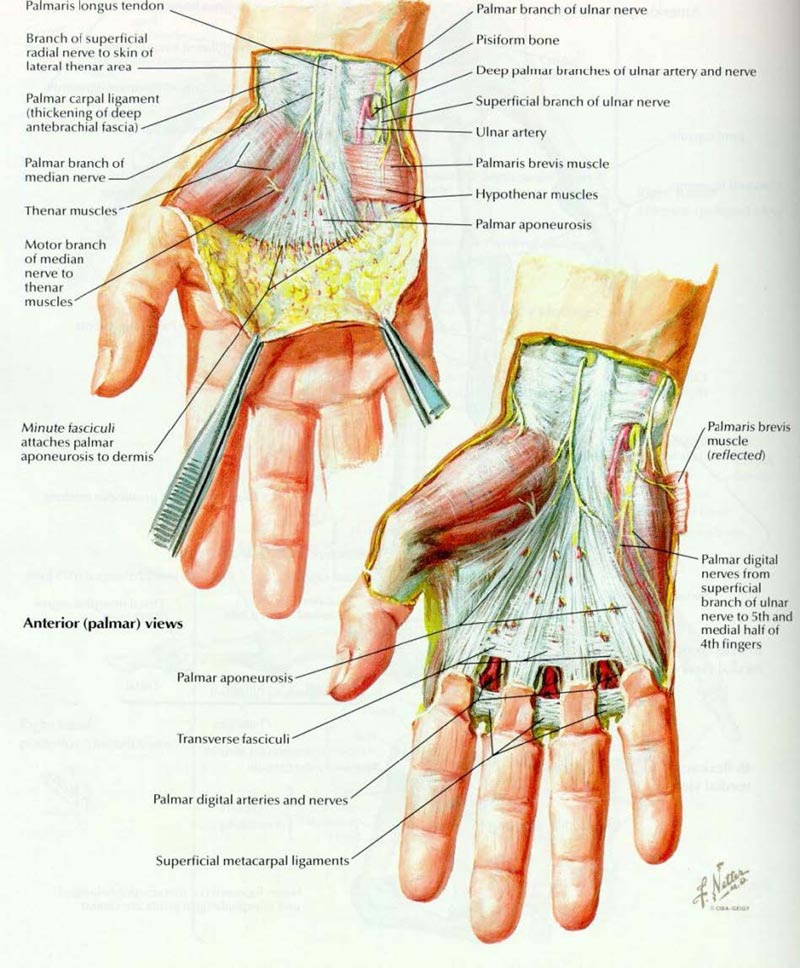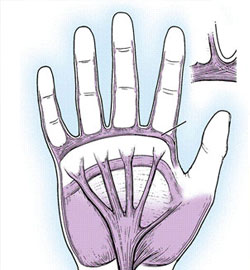
Dupytren’s Contracture
Dupuytren’s contracture is a genetic disorder in which the fascia of the hand contracts so that the fingers no longer fully extend. What is fascia? When you order a piece of meat, the tough gristle around the meat is fascia. In the hand, the fascia is composed of tough linear structures that lie just below the skin, but above the tendons that move the fingers.
Dupuytren’s contracture most often occurs in people of Scandinavian (Viking) ancestry. Now, the Vikings got around back when, so their genes often show up in people that don’t realize that they have some Viking ancestry in their family tree.
Dupuytren’s contracture often starts as a nodule in the hand. This nodule may be tender. Over time, the nodule grows and becomes a rope-like ‘cord’ that progressively pulls the digit closed. The rate of progression is genetically determined, but it can be accelerated by trauma. It’s not affected by work. There’s really nothing that can be done to slow down its progression; stretching is not effective. A tender nodule can be injected with steroid to decrease tenderness.
The Dupuytren’s cord should not be surgically removed until there is a contracture / loss of ability to extend the finger. This is because prematurely removing immature disease can speed up the disease’s progression. The best time to have it excised is when the metacarpophalangal (MP) joint – the big knuckle where the finger attaches to the hand – loses 30 degrees of extension, or the proximal phalangeal (PIP) joint – the middle knuckle of the finger – becomes noticeably involved.
As with many conditions, it’s a lot easier to treat Dupuytren’s Contracture early rather than late. Treatment options include Xiaflex, an enzyme that can dissolve part of the cord, Needle Fasciotomy, where the cord is cut with a needle in the office, or surgery. Both Xiaflex and Needle Fasciotomy are used primarily for MP joint contractures and do less well with a higher complication rate, when used to treat PIP joint contractures. Both Xiaflex and Needle Fasciotomy have much higher recurrence rates than surgery. Both work about the same. In fact, a recent research paper compared Xiaflex to Needle Fasciotomy and showed no difference in outcomes between them.1
Xiaflex is expensive ($3,000-4,000), but insurance companies may pay for some of this. Needle Fasciotomy uses just a needle, which is cheap. Needle Fasciotomy can be performed in the office during a single visit. Xiaflex injections are also performed in the office, but need to be set up in advance. The enzyme is injected in the clinic, and then the cord is ruptured the next day in clinic, so back-to-back clinic visits are involved.
Needle Fasciotomy improves contractures approximately 70%, with 30% remaining. It works better for the MP joint (80% gain in extension), compared to the PIP joint (54% gain in extension). At 2.0-2.5 years, the recurrence rate is 65-71%: 54-60% of PIP joint contractures recurred, while only 14% of MP joint contractures recurring. 42% underwent another procedure to treat their recurrent Dupuytren’s Contracture. At 5 years the reported recurrence rate is as high as 85%. The risk of nerve or artery injury is roughly 5%. 66 tendon lacerations were reported in a single physician survey. The complication rate for using Needle Fasciotomy for the PIP joint is 24%.2,5 Therefore, Needle Fasciotomy is used best to temporize MP joint contractures.
Most patients who have treatment for Dupuytren’s Contracture have more than one joint involved. For these patients, Xiaflex has a clinical success rate of 76% for the MP joint, and only 33% for the PIP joint. And the complication rate for using Xiaflex for PIP joint contractures is 93%(!)2 All patients treated in the most recent study had at least one adverse event (for example: pain requiring treatment, swollen lympth nodes, itching, and/or skin tears). Major complications included flexor tendon rupture and tendon sheath rupture; both of these complications require (at least one) surgery and hand therapy far more extensive than that for Dupuytren’s Contracture excision.2 A more recent study showed a 93% rate of recurrence for Xiaflex at 2 years.5
For those lucky enough to only have one joint involved, Xiaflex improves finger extension improved approximately 67% with a third of the contracture remaining. The initial success rate for the MP joint is 82%, but only 44% for the PIP joint. The recurrence rate is high: The recurrence rate at 2 years is 19-24% (14-18% for the MP joint and 34-41% for the PIP joint). The recurrence at 3 years is 34 (27% for the MP joint and 56% for the PIP joint). By 8 years, 2/3 of MP joint contractures and 100% of PIP joint contractures recurred (or were worse).
For more permanent results, surgical excision is an outpatient procedure that is not very painful at all. Surgical excision usually permanently cures the operated finger, with recurrence being very uncommon. Of course, genetics may cause Dupuytren’s Contracture to occur in other cords in other areas, but there’s not too much that can be done to change genetics, and all treatments share this same issue.
In my opinion, the key to decreasing pain, stiffness and complications with surgery is to leave part of the wound over the palm open. While this open area may look ‘gross’ for 4-6 weeks until it heals, it allows the swelling to escape. This decreases pain, stiffness and other complications. Once the wound has fully healed in 4-6 weeks, the scar will look no different than if it was sutured shut.
After surgery the hand is splinted for only 2 days and then hand therapy starts. It’s crucial to start using the hand early on to avoid stiffness. If the PIP joint required release, a hand therapist will make a custom splint that is worn only at night for 6 months. It is believed that night splinting helps decrease PIP joint recurrence rates.
Following surgery, the hand is kept clean and dry for 3 days: Bathing is safer than showering. Wrap a towel around the hand in case any water gets in, then place a plastic bag over the hand and secure it tightly with rubber bands. After 3 days showering is allowed. Afterwards, blot the hand dry, place antibiotic ointment in the open part of the wound, and cover it with a light dressing that allows hand use. Don’t submerge the wound under water until the stitches on the closed sections are removed after 2-3 weeks.
A recent research paper noted that Needle Fasciotomy is the cheapest option, but that surgery improved the patient’s quality of life the most.3 A government review study noted that surgery improved severe Dupuytren’s Contracture most effectively, with a greater patient satisfaction and a lower recurrence rate following surgery compared to needle fasciotomy.4
Most people are very satisfied by their surgical outcomes. The MP joint contracture usually resolves nearly completely. The PIP joint contracture usually improves at least 50%. That’s why it’s important to have surgery fairly soon after the PIP joint becomes noticeably contracted. If a residual PIP joint contracture is a problem there are other techniques that can be performed to straighten the PIP joint out (see the ‘Stiff Finger’ section of this website), but the motion regained after surgery usually makes the hand functional enough that nothing else needs to be done.
References:
1. Strömberg J, Ibsen-Sörensen A, Fridén J. Comparison of Treatment Outcome After Collagenase and Needle Fasciotomy for Dupuytren Contracture: A Randomized, Single-Blinded, Clinical Trial With a 1-Year Follow-Up. J Hand Surg. Sep;41A:873-80, 2016.
2. Skov ST, Bisgaard T, Søndergaard P, Lange J. Injectable Collagenase Versus Percutaneous Needle Fasciotomy for Dupuytren Contracture in Proximal Interphalangeal Joints: A Randomized Controlled Trial. J Hand Surg. 2017;42A:321-328.
3. Brazzelli M, Cruickshank M, Tassie E, McNamee P, Robertson C, Elders A, Fraser C, Hernandez R, Lawrie D, Ramsay C. Collagenase clostridium histolyticum for the treatment of Dupuytren’s contracture: systematic review and economic evaluation. Health Technol Assess. Oct;19:1-202, 2015.
4. Rodrigues JN, Becker GW, Ball C, Zhang W, Giele H, Hobby J, Pratt AL, Davis T. Surgery for Dupuytren’s contracture of the fingers. Cochrane Database Syst Rev. Dec 9;(12), 2015.
5. Skov ST, Bisgaard T, Søndergaard P, Lange J. Injectable Collagenase Versus Percutaneous Needle Fasciotomy for Dupuytren Contracture in Proximal Interphalangeal Joints: A Randomized Controlled Trial. J Hand Surg Am. 2017 May;42(5):321-328.

The Fascia of the Palm

In Dupytren’s contracture the palmar fascia becomes diseased.
